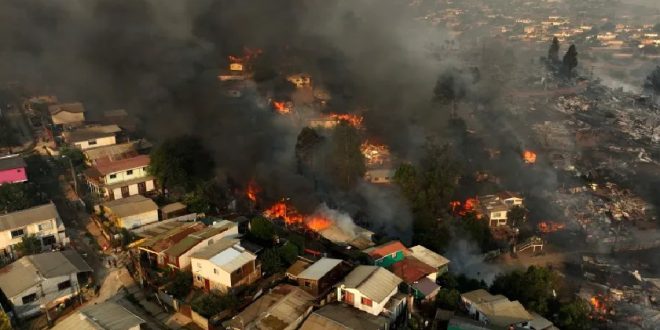05-02-2024
SANTIAGO: Firefighters have been wrestling with massive forest fires in central Chile.
Officials on Sunday extended curfews in the cities heavily affected by the blazes. They reported that at least 112 people have been killed since the fires began raging two days earlier.
 The flames are burning with the highest intensity around the city of Vina del Mar, where a famous botanical garden founded in 1931 was destroyed by the flames. At least 1,600 people were left homeless.
The flames are burning with the highest intensity around the city of Vina del Mar, where a famous botanical garden founded in 1931 was destroyed by the flames. At least 1,600 people were left homeless.
Several neighborhoods on the eastern edge of Vina del Mar were devoured by flames and smoke, trapping people in their houses. Officials said 200 people were reported missing in the city and surrounding area. A popular beach resort, the city of 300,000 hosts a well-known music festival during the summer.
On Sunday morning, Chilean President Gabriel Boric visited the town of Quilpe, which was also heavily affected by the fires. At that point, he reported that 64 people had been killed, and declared two days of national mourning.
Late on Sunday, Chile’s Forensic Medicine Service updated the confirmed death toll to 112. Boric warned that the number of casualties could rise as rescue workers search through collapsed homes. Some of those arriving at hospitals were in critical condition.
Rodrigo Mundaca, the governor of the Valparaiso region, said he believed some of the fires could have been intentionally caused, echoing a theory that the president has also mentioned.
 The fires began in hard-to-reach mountainous and forested areas but moved into densely populated neighborhoods despite the efforts of authorities to slow down the flames.
The fires began in hard-to-reach mountainous and forested areas but moved into densely populated neighborhoods despite the efforts of authorities to slow down the flames.
Officials asked people in areas affected by the fires to evacuate. Those farther from the fires were told to stay at home to facilitate the transit of fire engines and ambulances.
Curfews were declared in Vina del Mar, Quilpe and also the city of Villa Alemana, as part of an effort to prevent looting.
The fires broke out during a week of record-high temperatures in central Chile. Over the past two months, the El Nino weather pattern has caused droughts and high temperatures in Western South America.
Santiago, Chile’s capital and largest city, sits in a valley surrounded by the snow-capped Andes and the Chilean Coast Range. Plaza de Armas, the grand heart of the city’s old colonial core, is home to 2 neoclassical landmarks: the 1808 Palacio de la Real Audiencia, housing the National History Museum, and the 18th-century Metropolitan Cathedral. La Chascona is the home-turned-museum of poet Pablo Neruda. (Int’l Monitoring Desk)
 Pressmediaofindia
Pressmediaofindia




